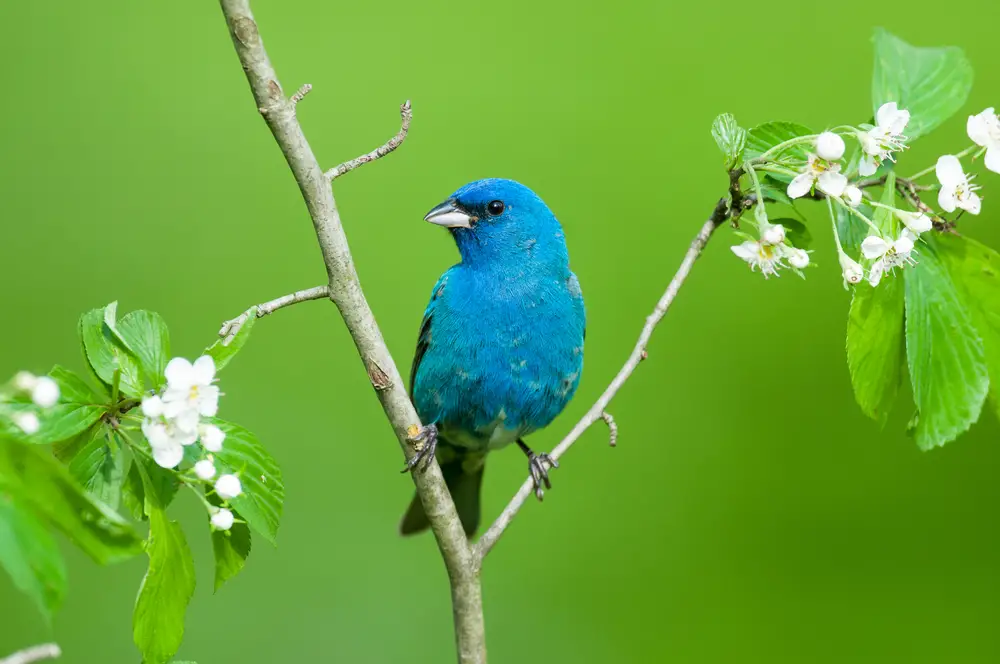The bright patch of sky in that tree was astounding, leaving you wondering how to attract indigo buntings to your backyard. Thankfully, this bird is easier to find than you may think.

These birds seem to be incredibly elusive, but in reality, you might already have them in your backyard. But how do you get them to become more visible?
Between adding food, shelter, and knowing what you’re looking for you’ll be delighted to find these colorful birds in your backyard without much effort.
Table of Contents
Indigo Buntings Are Really Cool
The males of this species are a bright blue and are often referenced to be like a slice of the sky. They have a brilliant and upbeat song that varies from region to region and they bring a bundle of delight to bird lovers of all ages.
Unfortunately, they’re hard to spot, which makes it hard to figure out how to attract indigo buntings to your backyard. Thankfully, there are some ways to bring in this colorful and happy bird.
Males usually use a butterfly-like approach when fighting over territory. They spread their wings and approach each other, flapping slowly.
During mating season, they may even attack each other. The birds actually learn their songs from one another, the males developing their songs from other males, though not their fathers.
These beautiful creatures are a bright delight to attract to your bird feeder.
Food is One Way to Bring Buntings in
These birds love a variety of different foods. Almost every kind of berry, common forager seeds such as dandelions, thistle, oats and so much more.
In the breeding areas of the northeast, though, you would have better luck with tree-related seeds, and moving insects such as caterpillars and worms. These birds adore these seeds but they like nyjer and thistle even more.
These birds aren’t incredibly picky, so you very well could have what you need to answer the question of how to attract indigo buntings to your backyard. If you’d like to increase your chances though, try thistle and nyjer seeds in your bird feeders to encourage them to check out your backyard.
It will be wonderful once you see these birds in your yard, but wouldn’t it be better if you were near to where they would be in the first place?
They Have to Nest Somewhere
These birds live in and near open woodlands, making it common to see them perched on a telephone line through the trees. They nest in shrubs and weeded areas in fields so you’re in luck if you’re near the woods or open fields.
Indigo Bustlings don’t commonly nest in birdhouses or in buildings at all. They like low places to raise their young and don’t like to be disturbed.
With only two broods a year and a few days to raise their young these birds can multiply quickly. So where you see one, you’re likely to see more.
They’ll be more easily found near old farms and at the edges or railroad tracks and power lines. So if you live near either you’ll be able to easily find these bright and brilliant creatures.
Common Hangouts
These birds don’t go far from their wooded wonderlands. The females nest low to the ground and will occasionally nest in crop plants.
They do not like cities, it won’t matter how much food you put out, or how low you put your shrubs. They dislike the noise of cities, so you won’t have much of a chance of seeing one unless you’re out in the country.
Take a look at power lines, railroad tracks, and the edges of fields, especially near barns. You may find one when you least expect it.
The males are easily spotted at feeders and along power lines and the edges of trees. You may have already seen them because they’re not always bright blue!
You Might Have Missed Them
If you’re wondering how to attract indigo buntings to your backyard, have you considered that they may already be right there at your feeder? Indigo Bustlings are not only just blue, but they can also actually be black.
So be careful not to mistake them for pesky birds that cause trouble! These birds are some of the few that you want around, but it’s easy to misidentify them.
These clever birds have a genetic adaption that lets their feathers refract light. This makes them look blue if they’re in the light, and darken when they’re in the shade. If one of these slices of the sky is in the shade, it’s nearly impossible to recognize them because they’re black in the shade.
They blend well in the dark shrubs they nest in and easily camouflage themselves when they fly with the light refraction trick. This keeps them well hidden from predators and helps them attract mates, sometimes of a different species.
The females don’t have any blue at all, and the young males rarely have blue. This makes finding this bird in your backyard difficult, it’s hard to know if they’re already there or not!
If you want Indigo Buntings around keep a careful eye on your bird feeders, always put them in the light. And always know what kind of bird you’re dealing with before you shoo it away.
Do You Have Indigo Buntings?
If you’re asking yourself how to attract indigo buntings to your backyard, you don’t have to go any further. Firstly, they may already be there, and if they’re not these bright birds have a very specific habitat that they like to live in and specific seeds that they adore.
You shouldn’t have any trouble attracting indigo buntings to your yard, as long as you use the right seeds. Having the right space around you doesn’t hurt and knowing what to look out for is your biggest challenge.
Keep an eye on those patches of light in your trees, you never know if you’ll spot this little slice of the sky.